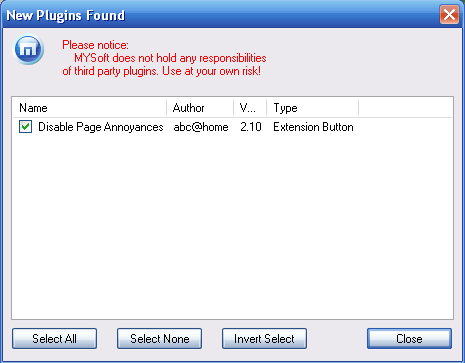Tutorial Plugin : 2 - Fichiers Plugin
Plugins are stored in the Maxthon/Plugin/PLUGINNAME folder. Every plugin has it's own folder. There are at least 3 files for every plugin necessary, all stored in the PLUGINNAME folder:
- plugin.ini
- ICONNAME.ico
- FILE.html
ICONNAME and FILE need to be defined in the plugin.ini file.
Les "plugins" sont rangés dans le dossier "..\Maxthon\plugin\Viewpage", ce qui correspond au plugin ayant pour nom "viewpage" rangé dans le dossier Plugin de Maxthon).
Chaque plugin a son propre dossier.
Il y a, au minimum, 3 fichiers nécessaires pour un plugin, tous stockés dans le dossier portant le nom du plugin :
- plug.ini
- iconname.ini
- File.html
Les noms de l'icône et du fichier doivent être défini dans le fichier plugin.ini.
Toolbar Plugins
Barre d'outil Plugin
The plugin.ini file looks like this for a toolbar plugin:
Le fichier plugin.ini ressemble à ceci, pour un plugin de barre d'outil :
[General] Name=Tester the pluginname Author=neo101 the author of the plugin Version=2.1b version number ModuleType=SCRIPT plugintype. Could be COM,EXE or SCRIPT FileName=test.html filename of the script that will be run if you press the button Comments=Test Plugin These comments are visible in Maxthon Options->Plugin->Maxthon Plugin Type=M2Plugin_BUTTON script type, could be M2Plugin_BUTTON or M2Plugin_SIDEBAR (not case sensitive) HotIcon=testhot.ico Icon that is visible if the user moves the mouse over the plugin button Icon=test.ico Icon that is always visible on the plugin toolbar (can be the same as HotIcon) [MyIE2Buttons] The dropdown menu (not required if you don't need a dropdown menu) Count=3 Number of visible dropdown items Name1=Test2 Name of dropdown item 1 FileName1=test2.html Filename of item 1 (can be the same as FileName under General) Name2=Test3 FileName2=scripts/test3.html If the file is in a subdirectory called 'scripts' Name3=Settings... FileName3=Config_caller.html [Settings] You can add your own items in the file (useful for settings) (not required) NewWindow=true Neo101IsNice=true
Download a basic plugin.ini file for a Toolbar Plugin hereVous pouvez télécharge un fichier plugin.ini de barre d'outil : ici
Sidebar Plugins
La barre d'outils des plugins
The plugin.ini file looks like this for a sidebar plugin:
Le fichier "plugin.ini" ressemble à ce qui suit, pour un plugin de barre d'outils :
[General] Name=Tester the pluginname Author=neo101 the author of the plugin Version=2.1b version number ModuleType=SCRIPT plugintype. Could be COM,EXE or SCRIPT FileName=test.html filename of the script that will be run if you press the button Comments=Test Plugin These comments are visible in Maxthon Options->Plugin->Maxthon Plugin Type=M2Plugin_SIDEBAR script type, could be M2Plugin_BUTTON or M2Plugin_SIDEBAR (not case sensitive) HotIcon=testhot.ico Icon that is visible if the user moves the mouse over the plugin button Icon=test.ico Icon that is always visible on the plugin toolbar (can be the same as HotIcon) [Settings] You can add your own items in the file (useful for settings) (not required) NewWindow=true Neo101IsNice=true Download a basic plugin.ini file for a Sidebar Plugin here
Vous pouvez télécharger un fichier "plugin.ini" pour une barre d'outils de plugins : iciConfig Window
Fenêtre de configuration
Since Maxthon v1.1.090 [2004-12-09] script plugins can use the configuration window. Example:
Depuis la verion 1.1.090 [du 9/12/2004] les plugins de script peuvent utiliser la fenêtre de configuration :
For Toolbar Plugins: You can call the window if you add a dropdown item in the plugin.ini file that links to a file with this code:
- Pour les plugins de barre d'outils :
Vous pouvez appeler cette fenêtre si vous ajoutez un article d'appel dans le fichier plugin.ini qui crée un lien vers un fihcier avec le code suivant :
<script language="JavaScript">
external.max_showConfig(%max_security_id,'PLUGINNAME')
</script>PLUGINNAME is the name of your plugin.
PLUGINNAME représente le nom de votre plugin.
For Sidebar Plugins: You can call the window if you add this code to your plugin:
- Pour les plugins de barre latérale :
Vous pouvez appeler la fenêtre si vous ajoutez le code suivant à votre plugin :
<a title="Show the configuration window"
href="javascript:external.max_showConfig(max_security_id,'PLUGINNAME')">
Config</a>NOTE: You can also access the configuration window if you open Maxthon Options->Plugin->Maxthon Plugin and press the 'config' button.
NOTE : Vous pouvez accéder aussi à la fenête de configuration par le menu Options -> Options de Maxthon -> Plugin [sélectionner le plugin visé) et cliquer sur le bouton "Configurer" [s'il est accessible pour ce plugin].
Maxthon will try to open config.html from your pluginfolder.Maxthon essayera d'ouvrir le fichier "config.html" du dossier de votre plugin.
A 'max.src' will be created with the security_id (see part 3 for more info about the security_id).Un "max.src" sera créé avec le "security_id" (aller voir la 3ème Partie pour plus d'informations sur le "securtiy_id").
The config.html should be a normal HTML page. You can change the height/width of the window with this code:
Le fichier "config.html" peut être une page Html normale. Vous pouvez changer les hauteur/largeur de la fenêtre avec ce code :
<meta name="Dialog-Width" content="110">
<meta name="Dialog-Height" content="120">
This code should be inside the <head> element.
Ce code devrait être placé à l'intérieur de l'élément <head>.
Download a basic config.html file here (Right Click->Save Target As...)
Télécharger un fichier "config.html" basique ici (clic-droit -> enregistrer la cible sous ...).
Install
If you put the plugin.ini file from your plugin in a directory in the maxthon/plugin folder and restart Maxthon, then Maxthon will automatically recognize your plugin. The pluginname and versionnumber are written into the Maxthon/config/plugins.ini file if you close Maxthon. Every time Maxthon starts it will check the Maxthon/config/plugins.ini file and check if the versionnumber has changed and if the plugin still exists. If the versionnumber, author, plugin type or pluginname changes than you will see the following dialog:
This does not happen if you modify any other file/item.
NOTE: changes to the name, versionnumber, icon, filenames and the dropdown menu (for toolbar plugins) are only effective after a restart of Maxthon. Changes to the content of plugin files are effective immediately.Sidebar plugin need to be refreshed for the changes to take effect (right click->refresh).
Partie 3: Commandes de Maxthon

